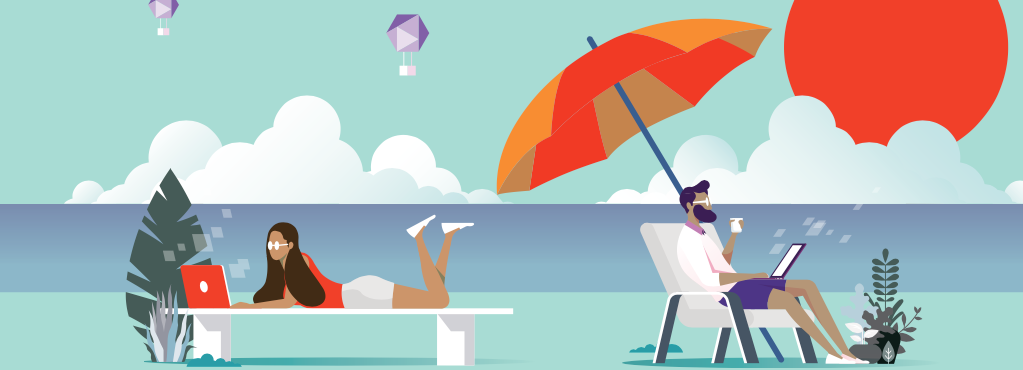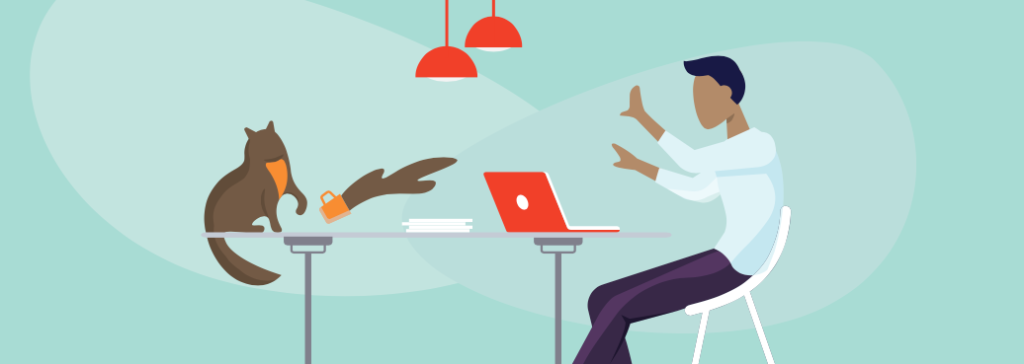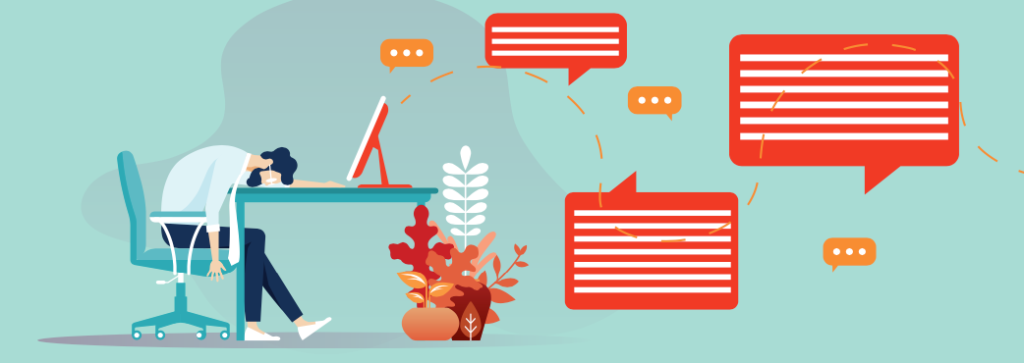Home office. That's not what we had in mind.
What you learn when the desire for freedom suddenly becomes a reality.
An essay from May 2020.
Comment: I've been invited by AvePoint Germany to write this essay and host a little webinar. The essay was originally published in German on the AvePoint Website and the sign-up for the Webinar (July 8th 2020) can be reached here. Illustrations provided and Copyright 2020 by AvePoint.
In recent years, the digitalisation of information work has led to much discussion about change and the "new work" model. With more flexibility, concepts such as open office space without individual offices (Open Office Space) and the disappearance of fixed seating (Shared Desk Models) have established themselves. Mobility and the (theoretical) independence from physical presence at the workplace have made the call for home office and work-life balance ever louder. The ever-increasing quality of virtual collaboration was quickly introduced as an opportunity to reduce travel costs. In the recent past, the struggle for a reduced carbon footprint has been added on top.
Quietly, the expected performance and the sheer volume of tasks have skyrocketed for many people in "information worker" roles. Answers and contributions were no longer a question of days or hours, but of minutes and seconds - whether working hours, weekends or holidays. Nobody ever explicitly asked for this, but high performers just go the "extra mile".

Effectiveness, knowledge networking and seamless collaboration across time zones and continents were the consultants' promises to executives and top management. The physical office and the need for personal presence became more and more the epitome of "old thinking" and the "old economy".
Then came the global pandemic in February 2020: COVID-19.
Within days, the constant desire of many employees to work from home and to spend less time for commute and business travel became a new reality. Offices were empty, and the virtual meeting rooms were packed back to back. The option of spending more time at home became an inevitable permanent state.

What seemed utterly impossible for business and IT managers had been turned into a global pilot by a virus - without a test phase, without training. The business case was simple: survival. Operational roles that previously seemed impossible without presence and meetings that would not deliver the desired results without the journey of 20 people halfway around the globe were successfully made from the kitchen table. Driving people without good reason out of the safety of their own home was quickly greeted with head-shaking through all levels.
Gathering the insights of two years in two months.
This turbo-digitisation has resulted in an almost global test field for the complete virtualisation of knowledge and information work. Not in the laboratory, but in real work scenarios, we were allowed to experience how desire and reality would stand side by side.
Learning 1: Perhaps we meant something else with freedom.
It didn't take long for the idea of working close to the family to be caught up with reality. In theory, wanting to be free to organise one's time often ignores an essential factor: the others - and not just colleagues. Many quickly wished for a touch less time with children or partner and more "face time" with colleagues. Who would have thought that?

Being able to work more from home and not having to spend all your time in offices or conference rooms has one factor that is often underestimated: the infrastructure - and not just a stable WiFi. Workspace, chair, table, break room and "space for coffee-kitchen chats" are factors that influence a working day and sometimes also give it structure. Suddenly the office no longer seemed so "old economy".
The physical working environment has become something that people suddenly long for. Perhaps even as much as the previously glorified freedom of "working anywhere, anytime". I'm sure that in the future it will be more the desire for balance and not the complete discarding of the so demonised work and office shackles.
Learning 2: IT is genuinely only the means to an end.
The fact that modern, digital work equipment is only as effective as the people who use it does not need to be discussed in detail at this point. However, the compact and seamless era of almost complete virtualisation of communication and collaboration has once again highlighted two essential aspects: The use of digital tools requires a clear, shared understanding of "which tool we use for which task". After all, without this agreement, things will quickly become more complicated than they were before. After all, the complexity of the joint tasks does not change but becomes higher since direct interaction is lost. Information no longer flows well, communication seems bumpy, expectations of each other and sometimes of oneself are not met. None of this helps to build trust in the new digital tools and virtual teams.
This explicit agreement becomes particularly relevant if there is no general concept, guideline or recommendation beforehand. The more people are left to their own devices in virtual collaboration, the more critical it becomes to consciously deal with the "Ways of Working" before starting to work together. The "how" becomes at least as necessary as the "what".
In addition to the agreement on the use of the tools, there are rules for working together. This is because indirect communication and cooperation via tools such as MS Teams or Slack, as well as direct exchange in many and sometimes long virtual meetings, needs a clear framework.
Preparation and follow-up work takes on a whole new meaning. The way to present, to be interrupted or to prepare contents must adapt to the new circumstances. Otherwise, humanity and empathy are the first building blocks of social togetherness, which will get lost in the new set-up. Because the informal exchange during breaks - "feeling" the others - does not take place if every break is also a break from the screen.
The fact that human (i.e. visual) interaction with colleagues is limited to virtual space can quickly become a psychological and emotional burden. Not only because the direct feedback, for example via facial expressions and gestures, is lost. Sitting in video conferences from morning to night has quickly led to massive media fatigue. The tendency towards shorter meetings was compensated for by the sheer number. More than one person shared with me that at the end of the working day, there was simply no energy left for a digital exchange with family and friends.
This experience will undoubtedly give a new direction to the desire for "more time from home working".

Learning 3: People deserve more trust
Let us not delude ourselves: the following certainly does not apply to the whole. But it applies to considerably more people than middle management, in particular, could have dreamed of.
Presence does not equal productivity. This was the main argument of those people who demanded more flexibility and working hours outside the office. For too many managers, however, the belief in real contribution and seriousness from remote workplaces was not given.
The COVID-19 situation has temporarily turned this desire of the employees into the norm. The result was remarkable: projects continued. Customer service teams were available. Customers were served. Strategies and plans were developed. Without business trips, commuting and endless meetings.

In addition to this vote of confidence, there was another factor for mutual success in this situation: When it counts, people help each other.
The use of digital tools for communication and collaboration was no longer optional with the overnight switch to the home office. Everyone had to participate, no matter how much experience they had or how comfortable they felt with it. This led to an unprecedented level of understanding and patience among colleagues. Video conferencing bingo ("I think you're on mute...") quickly became one of the most widespread memes on the Internet. If you take a close look at this bingo, it is symbolic of the shared experiences and hurdles that had to be overcome on the lightning journey into "new work".
Without extensive training and day-long introductions, people have come together in the new, digital world. It happened to such an extent that at least for once the wheels did not stop to a standstill. Sometimes the impression was created that the motivation was there to prove how well it all works.
Learning 4: Leadership is also care
Thanks to Simon Sinek, the last few years were shaped by the "Purpose" theme, the "why are we doing this"? This new meta-level of leadership was certainly the icing on the cake in the sermons on new management in the role of "coaches" and "guides" for employees and teams.
In light of the Corona crisis, this discussion has receded into the background. The focus has shifted to cooperation and collaboration. However, managers who had previously failed in conveying the shared purpose is in for a rough ride with a 100% virtual organisation.Making it clear to people that they have to pay even more attention to others as part of their own work is the task of managers. Consideration for the level of experience and well-being with digital tools of the people at the other end of the line is essential.

It is important not to suddenly lose parts of the organisation. The quality and above all, the clarity of indirect communication is also a new requirement. If a quick clarifying question also slips into virtual space, a communication overkill will develop quickly. So the question "Does the other person understand what I mean right away?" becomes a vital part of one's own work. Jamming everyone's calendars with video and telephone conferences without breaks must be prevented in the same way. Home office or any remote work does is not feasible in 10-hour live broadcast.
Rest periods, "being offline" and sharing without video is something managers need to pay more attention to. The natural environment for balance and recovery has been lost in the new digital world. Managers urgently need to promote awareness of the need for a break and rest time.
I find it charming, though, that playing children, life partners bringing coffee and sword fights in the background of video conferences have become a tolerated aspect. I wish we could maintain this new "professional ease" in dealing with each other beyond this time.
What comes next: tidy up, get everyone fully on-board, get in the new swing.
Slowly but surely normality returns to our working life. Offices fill up - albeit still with caution and distance. There is a little more life on the streets again. There are more planes in the sky.

Now it is time to process what we have learned and catch up on things that have fallen by the wayside at the necessary speed. Not only out of the danger of a new lockdown situation but also in terms of sustainability for more "virtualisation", we must now lay a solid foundation.
We have to finally onboard the people who were forced to go along and have entirely lost sight of their comfort zone. Not everyone has felt at home in the digital world right away, and even now, many still feel like they are in a foreign place. It may have a bed, but it's not your own. It is unsustainable to believe that everyone has been able to acquire the skills and behavioural patterns on an ad hoc basis that are needed in the long term for a more digitalised work model.
Anyone who now invests in consolidating and stabilising the common, digital foundation is doing so based on a reliable and robust wealth of experience. This should happen before the practice becomes theory again - and at the end of the day, no one will really want to have another go to get this chance.

